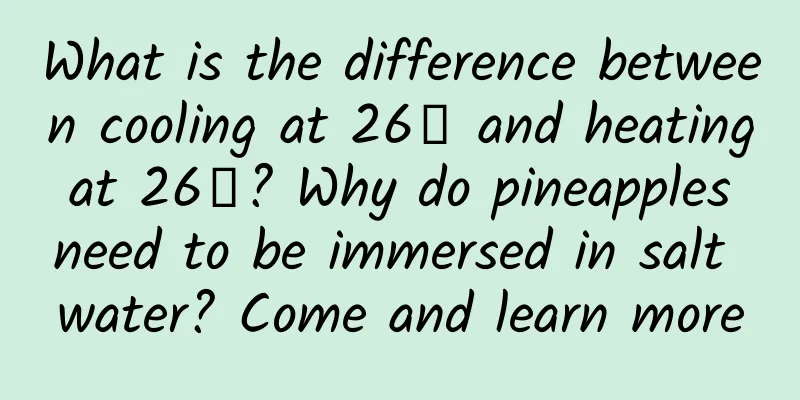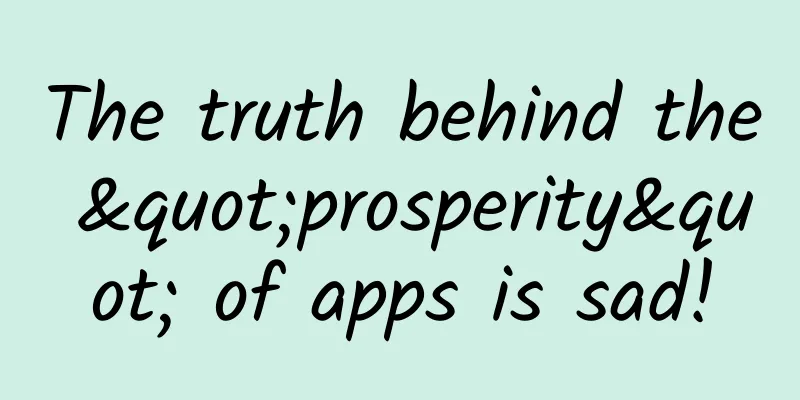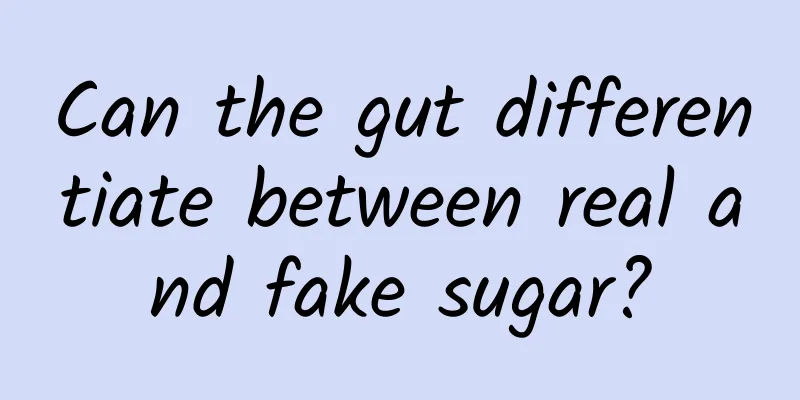What is the difference between cooling at 26℃ and heating at 26℃? Why do pineapples need to be immersed in salt water? Come and learn more

|
Turn on the air conditioner in winter Set to "Heating 26℃" Turn on the air conditioner in summer Set to "Cooling 26℃" Same 26℃ What is the difference between cooling and heating? Is there a difference between hot and cold at 26℃? Many people like to eat pineapple before Soak in salt water But why soak the pineapple in salt water? Why does eating too much pineapple at one time cause a sore mouth? What is the correct and scientific way to eat pineapple? … Let’s find out today ask: What does the temperature on the air conditioner mean? Why is it not warm at 26℃ in winter? by Anonymous The temperature displayed on the air conditioner generally refers to the set target temperature, that is, the temperature you want the room to reach, not the current indoor temperature. When the indoor temperature is not 26°C in winter, the air conditioner will stop heating when the indoor temperature reaches the set temperature in heating mode; if the current indoor temperature is higher than the set target temperature, the air conditioner will also stop heating. There are always exceptions. Some old-style air conditioners can only automatically adjust heating or cooling to make the indoor temperature tend to the target temperature in automatic mode, but always use maximum power for cooling in cooling mode and maximum power for heating in heating mode. At this time, the set target temperature is invalid (the editor once had such an air conditioner at home, haha). The cooling function of air conditioning utilizes the forced conversion and phase change cycle of refrigerant gas and liquid to achieve the "transfer" of heat from indoors to outdoors, while the heating mode generally reverses this cycle (which is much more energy efficient than simple resistance heating) to achieve indoor heating in winter. Source: Reference 1 The indoor temperature is related to the outdoor temperature, room size, room sealing, thermal insulation, air conditioner quality, air conditioner size, personnel flow, etc. In winter, the air conditioner is set to 26°C, which is a bit too large for the cold winter in the north. Assuming other conditions remain unchanged, the greater the temperature difference between indoor and outdoor, the greater the amount of heat that flows from indoor to outdoor through walls, windows, doors, etc. per unit time. To maintain the temperature, the efficiency of heat generation by the air conditioner must be improved. However, the heating efficiency of the air conditioner is limited. If the temperature difference is too large, it is difficult for the air conditioner to maintain the actual indoor temperature at the target temperature. After a period of time, the heat loss and the heating of the air conditioner reach a balance, and the actual indoor temperature will be below the target temperature. This is why sometimes it does not feel warm when the temperature is set at 26°C in winter. Of course, considering health and energy saving, the temperature difference between indoor and outdoor in winter should not be too large. References: 1. Air conditioning 2.What is the highest heating temperature of the air conditioner? by jita ask: Why do we need to soak pineapples in salt water before eating them? What is the most suitable concentration of salt water? by Pineapple is so delicious This is because pineapples contain a class of substances collectively called "bromelain", which cuts the peptide bonds in the primary structure of proteins and hydrolyzes them into polypeptides. When we chew pineapples, bromelain will destroy the structure of the oral mucosa. If we eat too much pineapple at one time, we will feel a strong tingling and burning sensation in the mouth and even the esophagus. Therefore, before eating pineapple, you need to try to remove bromelain first, and the best way to remove it is to inactivate it. The effective temperature for decomposing bromelain is about 40~60℃, and the effective pH value is about 4.0~8.0, so if you want to inactivate it, you can create a high temperature or an overly acidic or alkaline environment. Soaking pineapple in salt water is to adjust the pH of the environment and inactivate the enzyme. Seeing this, you will definitely ask, the main component of table salt at home is NaCl, how can it only create a neutral environment? Yes, if you use NaCl solution to soak pineapples, the effect is indeed not obvious. If you replace NaCl with baking soda (sodium bicarbonate, NaHCO₃) or soda (sodium carbonate, Na₂CO₃) and add it to water, the amount does not need to be too much, 1~2 teaspoons can make the solution weakly alkaline, or use hot water above 60℃ to soak pineapples, it can also destroy the structure of the enzyme and achieve the purpose of inactivation. However, the above method will affect the taste of the pineapple to some extent. If you have enough time, you can put the pineapple that has been treated at high temperature in the refrigerator before eating it, or simply make a dish of pineapple sweet and sour pork, wouldn’t it be delicious. References: [1] Bromelain [2] Why do we need to soak pineapples in salt water before eating them? [3] When you eat pineapple, the pineapple is actually “eating” you! by Eric ask: Why are some plant cells afraid of freezing, while others are not afraid of the cold even in Northeast China where the temperature is dozens of degrees below zero? Is there antifreeze in the cells? by Anonymous Generally, the damage caused by low temperature to plants can be divided into chilling injury and freezing injury. Chilling injury occurs above the freezing point. At this time, the activity of various enzymes contained in the cells of plants in a low temperature environment is reduced, and the plants cannot carry out normal physiological activities; while freezing injury occurs below the freezing point. When the water in the cells freezes, countless small ice crystals will destroy the cell membrane and organelles of the cells like small knives, causing serious damage to the plants. After a long period of natural selection, almost every plant living in a low temperature environment has its own unique cold resistance skills. Here we can only briefly introduce a few common ways. (1) Almost all plants enter a dormant period in winter, mainly to reduce the free water content in their bodies and slow down their metabolism. At this time, the osmotic pressure in the plant cells rises, the concentration of the "solution" rises, and the freezing point drops. From this perspective, it can be said that there is antifreeze in the cells. (2) Some plants contain a magical protein, plant antifreeze protein, which can inhibit the formation of ice crystals in cells through some special means, lowering the freezing point of the liquid in plant cells, while not affecting the melting point of the liquid. From this point of view, plant cells not only have antifreeze, but also very advanced antifreeze. (3) Similarly, some plants will automatically shed their leaves in winter to reduce water evaporation; or they may evolve structures that are more resistant to cold, such as growing into mat-like shapes and growing heat-insulating hairs, but these have little to do with antifreeze. References: [1]How do plants die from freezing? [2] How do plants resist cold? [3] Huang Fuzhen, Han Huacui, Zeng Xiaolin. Plant antifreeze protein and its application[J]. Biology Teaching, 2000, 000(012):P. by Qian Qian Si ask: Why does writing with a fountain pen on paper that has been soaked and then dried make the writing blurry? by Zhang, who loves physics First, let's take a look at what happens to paper during the process of being soaked and dried: when water soaks the paper, since the fiber molecules that make up the paper have hydrophilic hydroxyl groups, water molecules can enter the gaps between the fiber molecules, destroying the original hydrogen bonds between the fiber molecules. In the process of drying the paper, the evaporation rate of water in different parts of the fiber molecules is different. After drying, the binding force between the paper fibers decreases, the pores become larger, and the paper becomes loose and porous, which enhances the water absorption of the paper. Next, let's take a look at why the handwriting of a fountain pen will be blurred. There are three types of inks we use for daily writing: oily ink, neutral ink and water-based ink. Ballpoint pens generally use oily ink (but some ballpoint pens also use water-based ink), signature pens generally use neutral ink, and fountain pens generally use water-based ink. The types and properties of these three inks are very different. We can clearly feel that the water-based ink used in fountain pens has the strongest fluidity, and the other two inks are more viscous. Therefore, under the same paper conditions, the handwriting written by the fountain pen is more obviously blurred and easier to enter the gaps between the paper fibers. The combined effect of the above two factors leads to the feeling that writing with a fountain pen on paper that has been soaked and then dried will cause the handwriting to smudge. Reference: Why does paper become wrinkled and hard after being moistened and then dried? by Lazy 3:30 PM ask: Why do people wear a lot of clothes to keep warm in winter? Humans evolved from animals, but animals only rely on fur all year round. Is this considered degeneration? Is this change beneficial? by Anonymous This is certainly an evolution, and that’s why we’re called the Naked Ape. The ancestors of Homo sapiens were hairy. Looking at our cousins the gorillas, we gradually lost most of our thick and long body hair during the evolution process, and were replaced by fine hair all over the body (look at the fine hair on the back of your hand), and the hair density also decreased significantly: there are about 350 hair follicles per square centimeter on the top of the head (not considering bald people), 65 hair follicles per square centimeter on the back, and 75 hair follicles per square centimeter on the chest. There are many hypotheses to speculate why Homo sapiens lost body hair: sexual selection pressure, aquatic experience during evolution, parasites, use of clothes... Among so many hypotheses, the most widely accepted one is that the reduction of hair will improve the ability to regulate body temperature. With the reduction of body hair and the expansion of the distribution of eccrine sweat glands, humans have an unparalleled ability to regulate body temperature and can adapt very well to long-term high temperatures and long-term exercise (human endurance is extremely good, beating most mammals in high temperature environments). Millions of years ago, when human ancestors moved from the woods to the hot savannah, this hairless and less hairy trait was very good and necessary. Later, as humans spread to various regions, they learned to use animal fur to wrap their bodies for warmth, and the lack of body hair could well avoid external parasites, so the hairless phenotype was selected, and humans have been "naked" until now. Of course, there are exceptions in some parts. The dense hair of Homo sapiens (silence...) and the beards of male Homo sapiens are still long, hard, thick and dense. As for why male humans retain beards, the popular view is that this is the result of sexual selection. Hair growth is regulated by male hormones, and the vigorous facial beard means higher testosterone levels, so the retained beard can be used as an ornament to attract females and a symbol of the male's own status, which is the same reason why male birds have bright feathers. References: [1]Sandel. Brief communication: Hair density and body mass in mammals and the evolution of human hairlessness. American journal of physical anthropology. 2013. [2]Dixson et al. Cross-cultural variation in women's preferences for men's body hair. Adaptive Human Behavior and Physiology. 2019. [3]Dixson et al. The Role of Facial and Body Hair Distribution in Women's Judgments of Men's Sexual Attractiveness. 2016. by A large naked ape Source: Institute of Physics, Chinese Academy of Sciences (ID: cas-iop), Author: Frions This article has been authorized. Please contact the original author for reprinting. |
<<: Sixth Anniversary Raffia: Real Raffia, Not Raffia nor Grass
>>: How much of the oily fish known as "Splatoon" should you eat every day to be safe?
Recommend
The most comprehensive data analysis tool for TikTok
Nowadays, with the rapid development of the short...
In the past six months as a novice in operations, what pitfalls have I encountered?
Half a year ago, I suddenly had an idea, that is,...
Where is the way out for self-media in 2017?
Many operators now have a feeling: the number of ...
Huawei customer service responds to Android license expiration: Google services can still be updated but cannot be used on new phones
According to foreign media reports, the temporary...
IP account creation丨Master the core of IP operation in 3 dimensions
P account creation丨3 dimensions to master the cor...
What kind of people does the short video operation team need?
To form a team, you need to have your own team. T...
98-inch TVs enter households, the threshold is not high, and the performance is surprising
As the most important visual center and entertain...
High blood pressure ≠ hypertension! Stay away from high blood pressure and do these 6 things
Speaking of high blood pressure Many people feel ...
What are the differences between 2B and 2C in the core logic of business operations?
There is basically a consensus now: C-end product...
What is the interest rate of the special national debt for fighting the epidemic? How to buy the 2020 special government bonds
On June 18, the special government bonds were iss...
What are the functions of community group buying mini program? How much does it cost to make a group buying mini program?
It has been more than 5 years since the release of...
First time in China! The thousand-year-old lotus that lived at the same time as Su Shi and Li Qingzhao bloomed in Zhejiang
On July 12, staff from the Lishui Museum posted a...
How to fully plan a screen-sweeping event?
“Behind every successful case, there is a methodo...
The GuangDianTong delivery guide for the education industry optimizes the entire process!
Among the current mainstream information flow cha...
Luo Zhixiang is embroiled in a scandal. How can brands provide quick emergency assistance?
When a star falls from grace and is embroiled in ...









